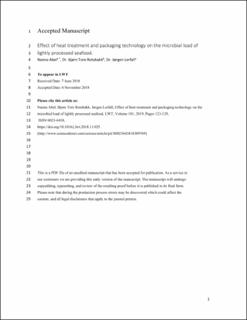| dc.contributor.author | Abel, Nanna Louise | |
| dc.contributor.author | Rotabakk, Bjørn Tore | |
| dc.contributor.author | Lerfall, Jørgen | |
| dc.date.accessioned | 2020-03-24T09:38:32Z | |
| dc.date.available | 2020-03-24T09:38:32Z | |
| dc.date.created | 2018-11-30T19:28:21Z | |
| dc.date.issued | 2019 | |
| dc.identifier.citation | Lebensmittel-Wissenschaft + Technologie. 2019, 101 123-129. | en_US |
| dc.identifier.issn | 0023-6438 | |
| dc.identifier.uri | https://hdl.handle.net/11250/2648282 | |
| dc.description.abstract | Increasing demands for lightly processed seafood stresses the need for development of non-intensive processing methods that ensures a safe product. The limitation to the shelf life of seafood is often ascribed to microbial activity. An experiment was design to investigate the influence of heat-treatments in combination with packaging technologies (vacuum (VAC), modified atmosphere (MA) packaging, or soluble gas stabilization (SGS)) on the microbial survival of inoculated species. Fish patties were inoculated with either Brochothrix thermosphacta or Listeria innocua before heat-treatment, packaging, and storage at 2 ᵒC for 16 days. Increased heat-treatment lowered the bacterial load throughout the storage and type of packaging technology affected the bacterial load significantly. VAC-samples had a significantly higher bacterial load than MA- and SGS-packaged samples, regardless of heat-treatment (L. innocua: 8.7 ± 0.1, 8.3 ± 0.1, 8.2 ± 0.1 log CFU x g−1, B. thermosphacta: 9.9 ± 0.1, 9.2 ± 0.1, 8.6 ± 0.1 log CFU x g−1, respectively) at end of storage. Furthermore, use of SGS significantly increased the bacterial inhibition by heat (0.5–0.6 log CFUx −1) and extended the lag phase of B. thermosphacta, as well as decreasing the growth rate of both inoculum species. It is concluded that use of SGS can fulfill the consumers’ demand of fresh, lightly processed seafood with a prolonged shelf life. | en_US |
| dc.language.iso | eng | en_US |
| dc.publisher | Elsevier | en_US |
| dc.rights | Attribution-NonCommercial-NoDerivatives 4.0 Internasjonal | * |
| dc.rights.uri | http://creativecommons.org/licenses/by-nc-nd/4.0/deed.no | * |
| dc.title | Effect of heat treatment and packaging technology on the microbial load of lightly processed seafood | en_US |
| dc.type | Peer reviewed | en_US |
| dc.type | Journal article | en_US |
| dc.description.version | acceptedVersion | en_US |
| dc.source.pagenumber | 123-129 | en_US |
| dc.source.volume | 101 | en_US |
| dc.source.journal | Lebensmittel-Wissenschaft + Technologie | en_US |
| dc.identifier.doi | 10.1016/j.lwt.2018.11.025 | |
| dc.identifier.cristin | 1637844 | |
| dc.description.localcode | © 2018. This is the authors’ accepted and refereed manuscript to the article. This manuscript version is made available under the CC-BY-NC-ND 4.0 license http://creativecommons.org/licenses/by-nc-nd/4.0/ | en_US |
| cristin.unitcode | 194,66,15,0 | |
| cristin.unitname | Institutt for bioteknologi og matvitenskap | |
| cristin.ispublished | true | |
| cristin.fulltext | original | |
| cristin.qualitycode | 1 | |

